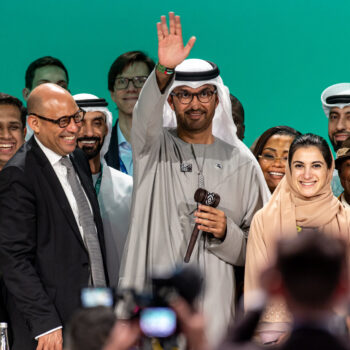The EU has led the way in getting its own house in order and could make or break COP26. But while we build our Green Deal at home, and were successful in bringing G7 partners towards climate neutrality.
However, the UN Environment Emissions gap report makes clear it is nowhere near enough to keep European citizens safe from devastating climate impacts – with emissions still projected to put us on 2.7C pathway.
Meanwhile, vulnerable partners are being hit by the economic impacts of COVID and climate-related extreme weather. Inside and outside Europe the world is, frequently literally, burning.
The EU is already doing its bit. Why does COP26 matter?
Because the Green Deal as the EU’s growth strategy is built on bringing international partners along. And not just the G7 – but China, Russia, and emerging economies like South Africa, India, and Indonesia. COP26 is a critical test for EU citizens and industry confidence that partners are on the path to climate neutrality. Leaders at COP26 will face greater scrutiny than ever, following a summer of devastating climate impacts, clear IPCC alarm bells and signals that we’re still far off track from a 1.5C pathway. An outcome on global emissions trading and the Paris Rulebook, while important, will not bolster confidence that partners beyond the G7 are equally invested in a green transition.
Concretely:
- Leverage experience as honest broker to re-build the high ambition coalition around accelerated action, on mitigation, adaptation and finance, at beyond COP. Leaders like Emmanuel Macron, Mario Draghi, Ursula Von der Leyen and even Angela Merkel can throw diplomatic weight behind COP26 as a launchpad for action. Working in concert to get leaders across the G20 on-board with the need to come back with stronger 2030 targets as early as 2023 to stand a chance of still influence the economic planning and infrastructure investments that can make or break efforts to halve emissions this decade.
- Be a real ally for vulnerable countries on finance, adaptation and loss and damage. This is important in and of itself – but also because countries like Brazil, China and Russia have been championing vulnerable country concerns to keep the spotlight off their own weak 2030 climate targets. This includes delivering EU contributions to a finance package that would respond to the realities of climate impacts on the ground , including committing to significantly increase finance for supporting climate-vulnerable countries in adapting to changing climates and impacts. EU Countries like Denmark and the Netherlands are already contributing 50% or more to adaptation and progressive EU+ Vulnerable country groups have come out in support of this ask provide. The rest of the EU, alongside other climate finance providers, will be under scrutiny to follow suit. Additionally, progress is needed in identifying how least-responsible countries will be supported in rebuilding their economies and societies from the losses and damages caused by mounting climate-related disasters, such as hurricanes or flooding.
- Get behind mobilizing at-scale investment for emerging economies’ green transition. Helping countries who may be open to increased ambition by 2023 (like potentially Indonesia, India, South Africa) if they had confidence that significant financial firepower would be mobilized to support them can be more impactful than any Carbon Border Adjustment Mechanism.
These can build a successful COP, through the High Ambition Coalition, the Cartagena dialogue, bilateral and informal diplomatic channels.
We are almost at Climate Judgement Day. Coordinated EU action can unlock roadblocks to a COP that gives citizens and industries confidence the world is moving with us toward credible climate neutrality.



